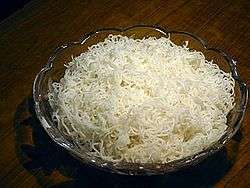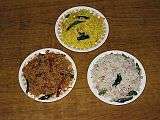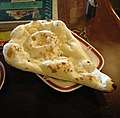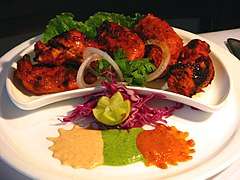Sevai
Sevai (Tamil: சேவை), shavige (Kannada: ಶಾವಿಗೆ) or santhakai (Western Tamil Nadu: சந்தகை), or Saemia is a type of rice vermicelli popular in Southern India, particularly Tamil Nadu (Kongunadu region), Karnataka KARUNADU] and some parts of Kerala. While typically made from rice, varieties made out of other food grains like wheat, ragi, etc. can also be found. Sevai is popular throughout South India as a meal throughout the day.
 Freshly extruded Sevai | |
| Alternative names | Shavige |
|---|---|
| Type | Rice noodle/rice vermicelli |
| Place of origin | India |
| Region or state | Tamil Nadu and Karnataka |
| Main ingredients | Rice |
| Variations | Santhakai |
Preparation
Sevai is mostly made fresh starting from rice grains. It is also prepared from dried sevai packs (or rice sticks) like the instant ones in the Asian grocery stores. Traditionally, making of sevai at home consists of the following steps (with minor variations based on location and family customs):
- Soaking of parboiled rice in cold water for about 3 hours
- Grinding of soaked rice using a wet grinder into a fine paste
- Making of dumplings from the rice paste and steaming the chunks (at least three variations are known in this step as follows)
- Sautéeing the paste into dough, make dumplings (also called kozhukkottais, steam the same on an idli vessel)
- pour the paste into moulds of the idli vessel and steam the same
- Sautéeing the paste into dough, make dumplings, drop the same into boiling water and through cook
- Sautéeing the paste into dough, make medium-sized balls of the dough and pass it through "sevai press" into idli plates and then steam it
- Pressing of cooked dumplings into fine strands using a type of sevai press
Ingredients
Homemade sevai is often made from 100% rice (in addition to water and salt) whereas dry rice sticks may often have some additives like tapioca, corn starch, etc. Instant rice noodles have other additives like Wheat gluten, Guar gum, edible starch, etc. In Southern parts of Karnataka, shyaavige is made of different grains with different consistencies. When made with ragi or millet the vermicelli is fatter, whereas when made with rice or wheat the strands are thinner.
Sevai versus Idiyappam
Sevai is similar to idiyappam, in the ingredients and preparation. Sevai, unlike idiyappam, is typically broken or cut up rather than in piles of noodles. In this way, sevai is treated almost as a substitute for rice. Idiyappam, by contrast, is served almost as a substitute for appam with side dishes like curries or kormas.

The press used to make sevai and idiyappam are essentially the same. Sevai is also typically not served with curries other side dishes, but rather mixed with a flavoring like lemon, tamarind paste, coconut, or uddina pudi (a type of powder made from black gram dal in Karnataka). Called shavige in Karnataka, it can also be prepared with cooked vegetables and tempered with spices with a dash of lemon juice.
Sevai is typically served in Tamil Nadu and other South Indian communities as a breakfast or tiffin dish, but also served as a dessert such as payasam when cooked in milk with cardamom or other spices and sugar. The cuisine of Kongu region in Tamilnadu has a variation of this with a name Santhagai and included in wedding ceremony rituals of the region. In the Malnad region of Karnataka, it may be served with chicken curry, rather unlike how it is usually served in other parts of South India. Sankethi communities also differ from the norm in that they prepare idiyappam and serve it like sevai, flavored with lemon, tamarind, or uddina pudi. Other variants of sevai (or idiyappam for that matter) can be made with ragi, jowar, or other grains are served plain with accompaniments like sweetened coconut milk and various edible powders that include powdered chickpea and sesame. In Tamil Nadu santhakai is often flavoured with lemon, tamarind, tomato, coconut, curd etc. and is usually eaten warm.


